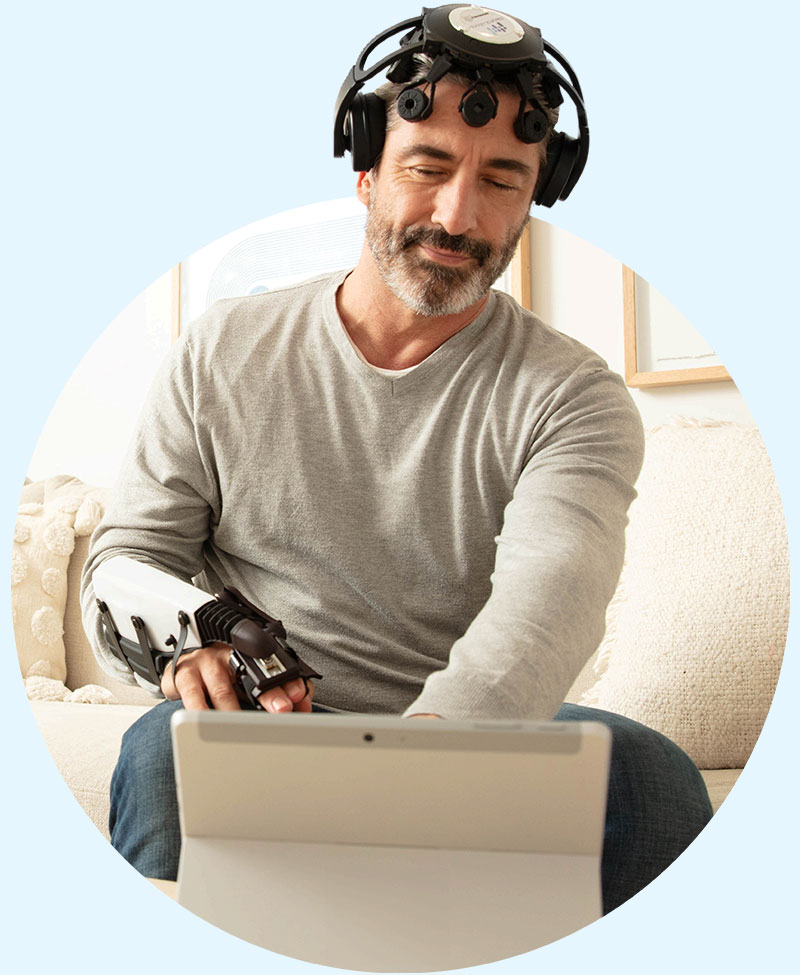IpsiHand®
Have you suffered a stroke?
Struggling with arm function?

IpsiHand uses your healthy brain activity when thinking about movement to retrain a new part of your brain to control your disabled arm.
How IpsiHand Works

1.
After Stroke
Motor cortex damage can result in impaired motor function, limiting arm and hand movement. The muscles in the arm and hand are fine, but the brain has a hard time connecting.
3.
Therapy
IpsiHand recognizes your intent from healthy parts of your brain by opening and closing your hand when you imagine movement.
2.
Imagine
As you concentrate on moving the affected hand, healthy areas of the brain produce signals that are sensed by the EEG Headset.

2.
Imagine
As you concentrate on moving the affected hand, healthy areas of the brain produce signals that are sensed by the EEG Headset.
3.
Therapy
IpsiHand recognizes your intent from healthy parts of your brain by opening and closing your hand when you imagine movement.
4.
Re-Connect
Repeated therapy may improve motor functioning by strengthening neural connections and encouraging new pathways to healthy parts of the brain.
User Outcomes
70% Approximately 70% of clinical trial subjects improved functional movements of their arm and hand. ††
All Users All study subjects who completed the AMAT demonstrated clinically significant improvement of functional tasks requiring upper extremity use.†
+8.1 FUGL-MEYER In the most recent clinical study, patients meeting acceptance criteria demonstrated an average improvement of 8.1 points on the Fugl-Meyer Assessment, widely regarded as the gold standard for evaluating arm function after stroke.††


The System
IpsiHand’s brain-computer interface (BCI) technology lets you control movement with your thoughts.
As you imagine hand movement, IpsiHand senses signals from the healthy areas of your brain, guiding gentle motion to enhance motor function. This innovative approach may improve motor function by strengthening the connection between your arm and brain to promote new neural pathways.
Learn More About IpsiHand
The IpsiHand Upper Extremity Rehabilitation System is an at-home therapy for individuals with chronic stroke impairments.
IpsiHand includes three components:

Handpiece
Powered by your thoughts, the wireless motion assist device moves the affected hand open and closed.

Headset
The non-invasive EEG headset measures areas of healthy brain activity, identifying your “intention to move” your hand.

Tablet
The tablet guides you through your daily therapy sessions and will provide you results on your performance.
At-Home Therapy
Has Never Been Easier.
Our non-invasive treatment allows for intensive rehabilitation almost anywhere. You can even pack up IpsiHand and take therapy on the road.
Learn More
Take a look at what makes IpsiHand so ground-breaking.
Featured On Bloomberg
Stroke survivor Mark Forrest’s inspiring journey with Neurolutions’ IpsiHand EEG headset highlights the transformative power of neurorehabilitation.
IpsiHand Tips & Setup
Learn how to setup the Neurolutions IpsiHand system so you can start your journey to promote use of you arm and hand after stroke.
How IpsiHand Works
Unveil the future of neurorehabilitation with the IpsiHand system, empowering stroke patients to regain arm and hand control through brain-computer interface technology.
What Is IpsiHand?
Learn how the IpsiHand system empowers functional independence by harnessing the power of their mind, revolutionizing stroke rehabilitation.
Mark Forrest Stroke Survivor
Mark’s journey to get back on the water.
A Groundbreaking Partnership
Neurolutions & Kandu: A Decade of Innovation
Take IpsiHand for a Spin
CLICK FOR 360 VIEW
†Affairs, Office of Regulatory. “FDA Authorizes Marketing of Device to Facilitate Muscle Rehabilitation in Stroke Patients.” U.S. Food and Drug Administration, FDA, www.fda.gov/news-events/press-announcements/fda-authorizes-marketing-device-facilitate-muscle-rehabilitation-stroke-patients. Accessed 16 Dec. 2024.
†† Rustamov N, Souders L, Sheehan L, Carter A, Leuthardt EC. IpsiHand Brain–Computer Interface Therapy Induces Broad Upper Extremity Motor Rehabilitation in Chronic Stroke. Neurorehabilitation and Neural Repair. 2024;0(0). doi:10.1177/15459683241287731
